Geometry Effect on Microstructure and Mechanical Properties in Laser Powder Bed Fusion of Ti-6Al-4V
Abstract
:1. Introduction
2. Materials and Methods
2.1. Test Sample Design
2.2. LPBF Manufacturing and Machining
2.3. Microstructural Characterization
2.4. Machining
2.5. Mechanical Characterization and Fracture Surface Evaluation
2.6. Thermal Simulation and Correlation
3. Results and Discussion
3.1. Geometry Effect on Microstructure
3.2. Geometry Effect on Mechanical Properties
3.2.1. Geometry Effect on Fatigue Properties
3.2.2. Geometry Effect on Ultimate Tensile Strength
3.3. Simulation of Thermal History
3.4. Correlation between Mechanical Properties and Simulated Thermal History
4. Conclusions
Author Contributions
Funding
Data Availability Statement
Conflicts of Interest
References
- Berrocal, L.; Fernández, R.; González, S.; Periñán, A.; Tudela, S.; Vilanova, J.; Rubio, L.; Martín Márquez, J.M.; Guerrero, J.; Lasagni, F. Topology optimization and additive manufacturing for aerospace components. Prog. Addit. Manuf. 2019, 4, 83–95. [Google Scholar] [CrossRef]
- Chahal, V.; Taylor, R.M. A review of geometric sensitivities in laser metal 3D printing. Virtual Phys. Prototyp. 2020, 15, 227–241. [Google Scholar] [CrossRef]
- Barriobero-Vila, P.; Artzt, K.; Stark, A.; Schell, N.; Siggel, M.; Gussone, J.; Kleinert, J.; Kitsche, W.; Requena, G.; Haubrich, J. Mapping the geometry of Ti-6Al-4V: From martensite decomposition to localized spheroidization during selective laser melting. Scr. Mater. 2020, 182, 48–52. [Google Scholar] [CrossRef]
- Zhao, C.; Fezzaa, K.; Cunningham, R.W.; Wen, H.; de Carlo, F.; Chen, L.; Rollett, A.D.; Sun, T. Real-time monitoring of laser powder bed fusion process using high-speed X-ray imaging and diffraction. Sci. Rep. 2017, 7, 3602. [Google Scholar] [CrossRef] [PubMed]
- Longhitano, G.A.; Larosa, M.A.; Jardini, A.L.; Zavaglia, C.A.d.C.; Ierardi, M.C.F. Correlation between microstructures and mechanical properties under tensile and compression tests of heat-treated Ti-6Al–4 V ELI alloy produced by additive manufacturing for biomedical applications. J. Mater. Process. Technol. 2018, 252, 202–210. [Google Scholar] [CrossRef]
- Erdakov, I.; Glebov, L.; Pashkeev, K.; Bykov, V.; Bryk, A.; Lezin, V.; Radionova, L. Effect of the Ti6Al4V Alloy Track Trajectories on Mechanical Properties in Direct Metal Deposition. Machines 2020, 8, 79. [Google Scholar] [CrossRef]
- Barriobero-Vila, P.; Gussone, J.; Haubrich, J.; Sandlöbes, S.; Da Silva, J.C.; Cloetens, P.; Schell, N.; Requena, G. Inducing Stable α + β Microstructures during Selective Laser Melting of Ti-6Al-4V Using Intensified Intrinsic Heat Treatments. Materials 2017, 10, 268. [Google Scholar] [CrossRef] [PubMed]
- Xu, W.; Brandt, M.; Sun, S.; Elambasseril, J.; Liu, Q.; Latham, K.; Xia, K.; Qian, M. Additive manufacturing of strong and ductile Ti–6Al–4V by selective laser melting via in situ martensite decomposition. Acta Mater. 2015, 85, 74–84. [Google Scholar] [CrossRef]
- Sieniawski, J.; Ziaja, W.; Kubiak, K.; Motyk, M. Microstructure and Mechanical Properties of High Strength Two-Phase Titanium Alloys. In Titanium Alloys—Advances in Properties Control; Sieniawski, J., Ziaja, W., Eds.; InTech: Rijeka, Croatia, 2014; ISBN 978-953-51-1110-8. [Google Scholar]
- Wei, H.L.; Mukherjee, T.; Zhang, W.; Zuback, J.S.; Knapp, G.L.; De, A.; DebRoy, T. Mechanistic models for additive manufacturing of metallic components. Prog. Mater. Sci. 2021, 116, 100703. [Google Scholar] [CrossRef]
- Körner, C.; Markl, M.; Koepf, J.A. Modeling and Simulation of Microstructure Evolution for Additive Manufacturing of Metals: A Critical Review. Met. Mater. Trans. A 2020, 51, 4970–4983. [Google Scholar] [CrossRef]
- Nandwana, P.; Plotkowski, A.; Kannan, R.; Yoder, S.; Dehoff, R. Predicting geometric influences in metal additive manufacturing. Mater. Today Commun. 2020, 25, 101174. [Google Scholar] [CrossRef]
- Pantawane, M.V.; Ho, Y.-H.; Joshi, S.S.; Dahotre, N.B. Computational Assessment of Thermokinetics and Associated Microstructural Evolution in Laser Powder Bed Fusion Manufacturing of Ti6Al4V Alloy. Sci. Rep. 2020, 10, 7579. [Google Scholar] [CrossRef] [PubMed]
- Liang, H.; Xie, D.; Mao, Y.; Shi, J.; Wang, C.; Shen, L.; Tian, Z. The Size Effect on Forming Quality of Ti–6Al–4V Solid Struts Fabricated via Laser Powder Bed Fusion. Metals 2019, 9, 416. [Google Scholar] [CrossRef] [Green Version]
- Shrestha, R.; Shamsaei, N.; Seifi, M.; Phan, N. An investigation into specimen property to part performance relationships for laser beam powder bed fusion additive manufacturing. Addit. Manuf. 2019, 29, 100807. [Google Scholar] [CrossRef]
- Leicht, A.; Klement, U.; Hryha, E. Effect of build geometry on the microstructural development of 316L parts produced by additive manufacturing. Materials Characterization. Mater. Charact. 2018, 143, 137–143. [Google Scholar] [CrossRef]
- Walker, J.R. Multi-Sensor Approach to Determine the Effect of Geometry on Microstructure in Additive Manufacturing. 2019. Available online: https://corescholar.libraries.wright.edu/etd_all/2145 (accessed on 27 January 2022).
- Promoppatum, P.; Yao, S.-C.; Pistorius, P.C.; Rollett, A.D.; Coutts, P.J.; Lia, F.; Martukanitz, R. Numerical modeling and experimental validation of thermal history and microstructure for additive manufacturing of an Inconel 718 product. Prog. Addit. Manuf. 2018, 3, 15–32. [Google Scholar] [CrossRef]
- Nitzler, J.; Meier, C.; Müller, K.W.; Wall, W.A.; Hodge, N.E. A novel physics-based and data-supported microstructure model for part-scale simulation of laser powder bed fusion of Ti-6Al-4V. Adv. Model. Simul. Eng. Sci. 2021, 8, 1–39. [Google Scholar] [CrossRef]
- Martin, A.A.; Calta, N.P.; Khairallah, S.A.; Wang, J.; Depond, P.J.; Fong, A.Y.; Thampy, V.; Guss, G.M.; Kiss, A.M.; Stone, K.H.; et al. Dynamics of pore formation during laser powder bed fusion additive manufacturing. Nat. Commun. 2019, 10, 1987. [Google Scholar] [CrossRef] [Green Version]
- Liu, S.; Shin, Y.C. Additive manufacturing of Ti6Al4V alloy: A review. Mater. Des. 2019, 164, 107552. [Google Scholar] [CrossRef]
- Vanmeensel, K.; Lietaert, K.; Vrancken, B.; Dadbakhsh, S.; Li, X.; Kruth, J.-P.; Krakhmalev, P.; Yadroitsev, I.; van Humbeeck, J. Additively manufactured metals for medical applications. In Additive Manufacturing; Elsevier: Amsterdam, The Netherlands, 2018; pp. 261–309. ISBN 9780128121559. [Google Scholar]
- Thijs, L.; Verhaeghe, F.; Craeghs, T.; van Humbeeck, J.; Kruth, J.-P. A study of the microstructural evolution during selective laser melting of Ti–6Al–4V. Acta Mater. 2010, 58, 3303–3312. [Google Scholar] [CrossRef]
- Rafi, H.K.; Karthik, N.V.; Gong, H.; Starr, T.L.; Stucker, B.E. Microstructures and Mechanical Properties of Ti6Al4V Parts Fabricated by Selective Laser Melting and Electron Beam Melting. J. Mater. Eng. Perform. 2013, 22, 3872–3883. [Google Scholar] [CrossRef]
- Lui, E.W.; Xu, W.; Pateras, A.; Qian, M.; Brandt, M. New Development in Selective Laser Melting of Ti–6Al–4V: A Wider Processing Window for the Achievement of Fully Lamellar α + β Microstructures. JOM 2017, 69, 2679–2683. [Google Scholar] [CrossRef] [Green Version]
- Sallica-Leva, E.; Caram, R.; Jardini, A.L.; Fogagnolo, J.B. Ductility improvement due to martensite α’ decomposition in porous Ti-6Al-4V parts produced by selective laser melting for orthopedic implants. J. Mech. Behav. Biomed. Mater. 2016, 54, 149–158. [Google Scholar] [CrossRef] [PubMed]
- Ali, H.; Le, M.; Ghadbeigi, H.; Mumtaz, K. In-situ residual stress reduction, martensitic decomposition and mechanical properties enhancement through high temperature powder bed pre-heating of Selective Laser Melted Ti6Al4V. Mater. Sci. Eng. A 2017, 695, 211–220. [Google Scholar] [CrossRef]
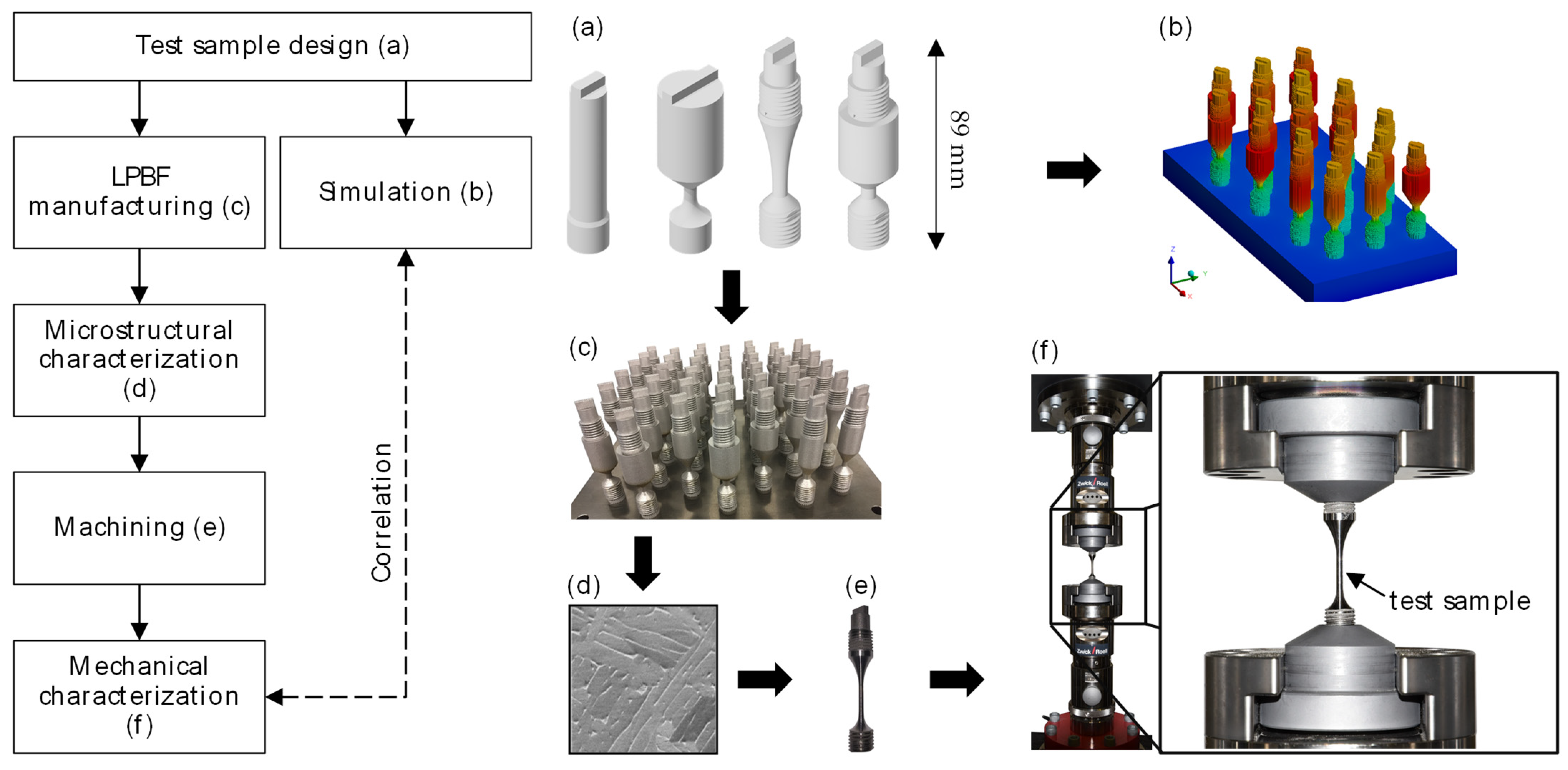


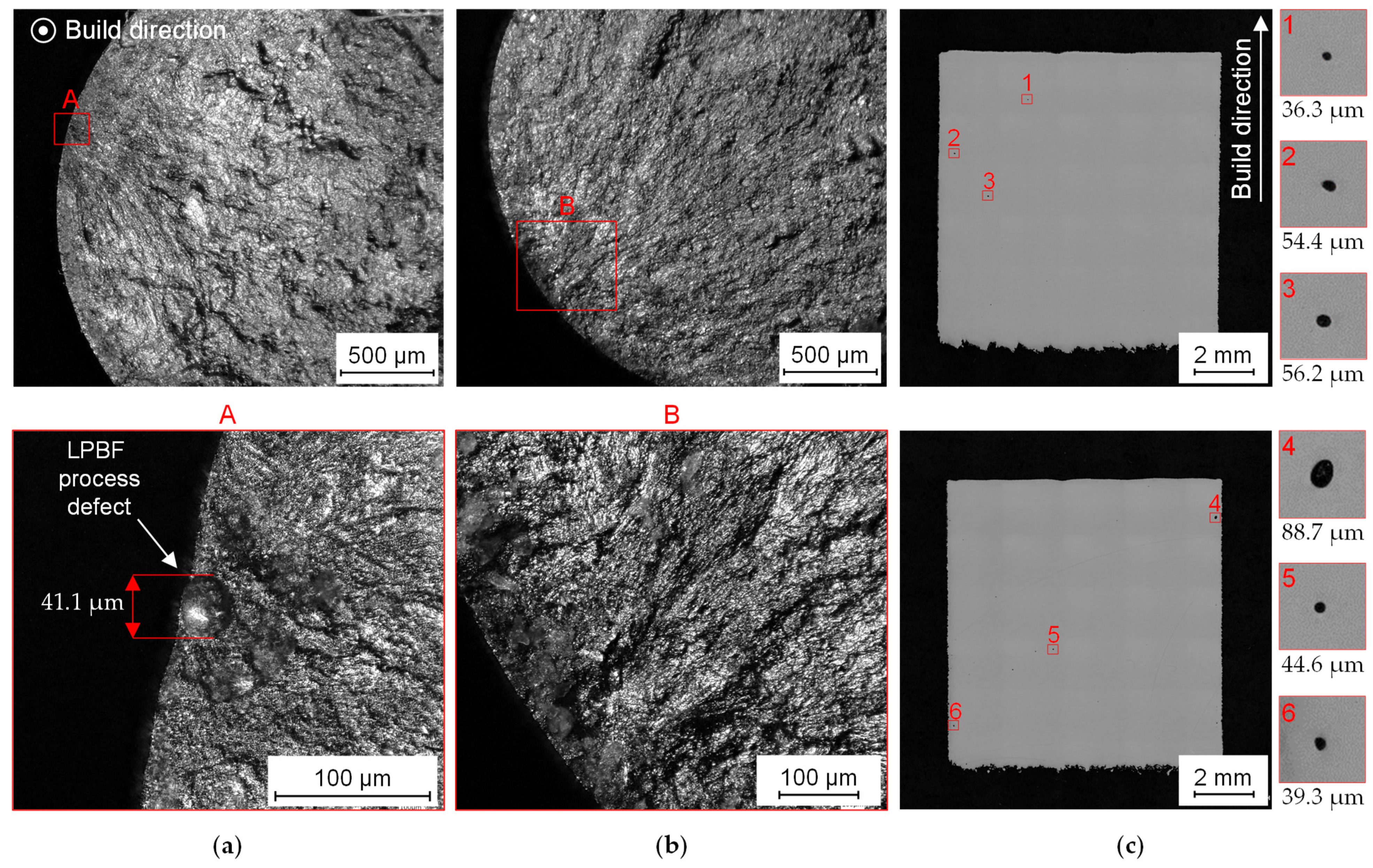
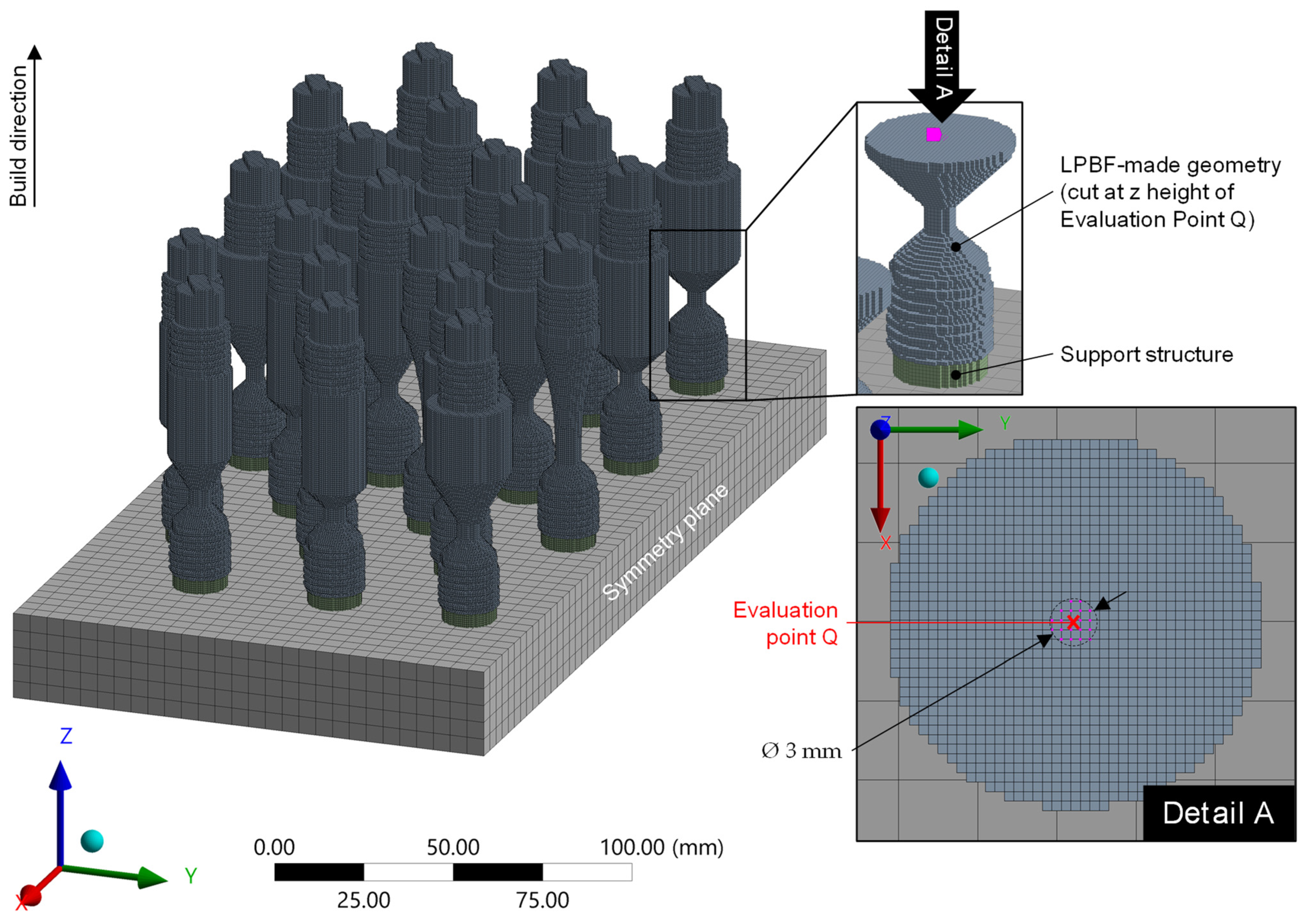


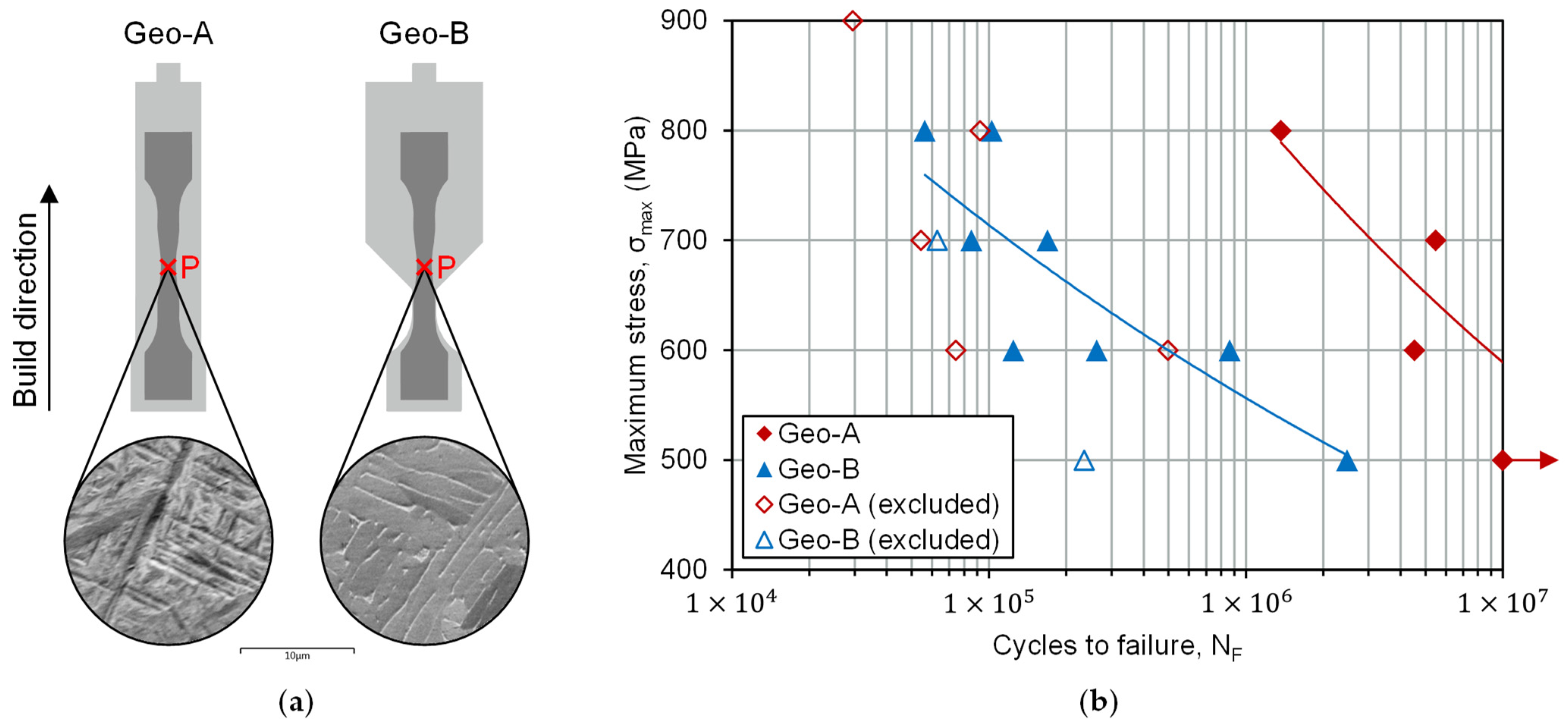
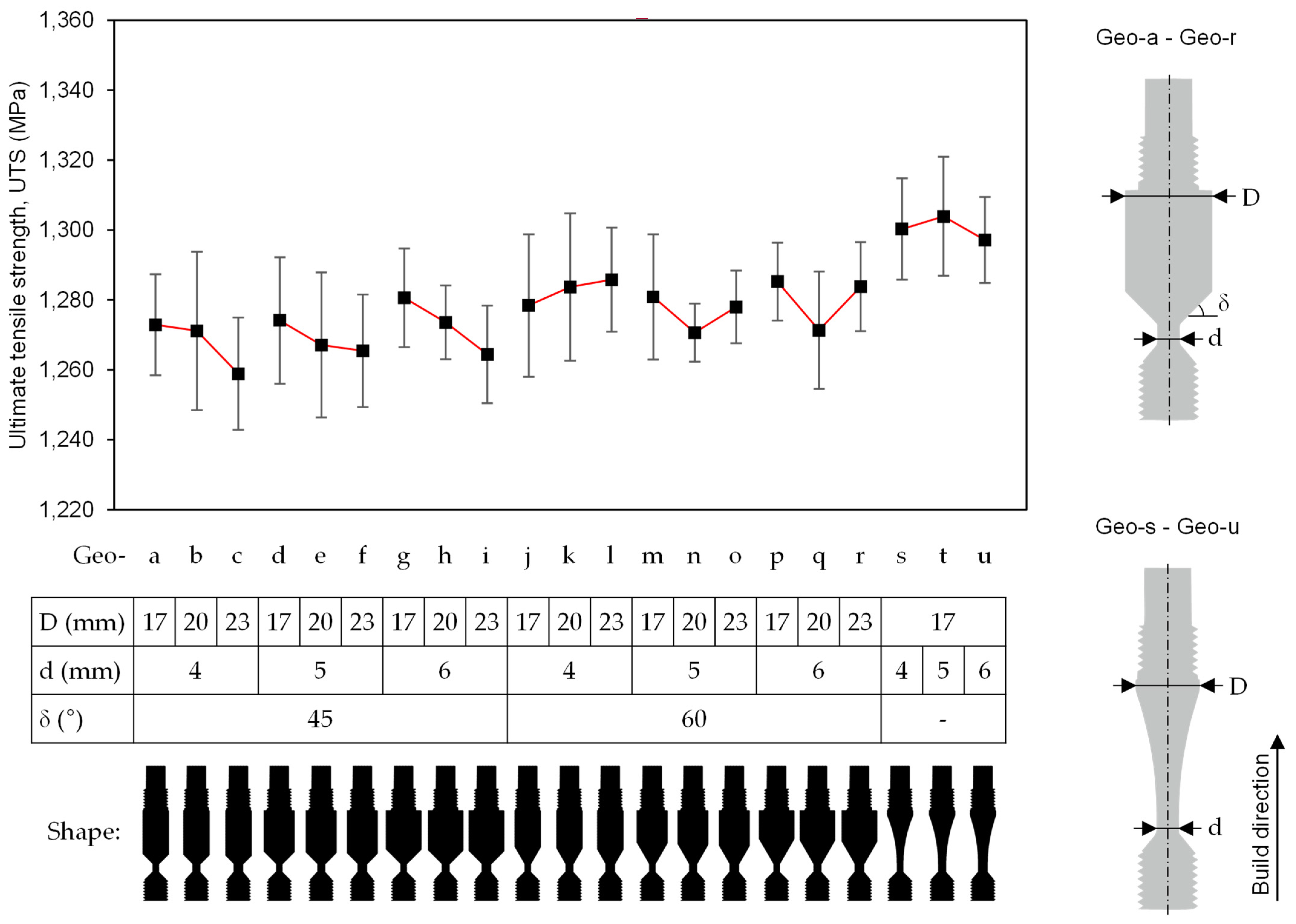

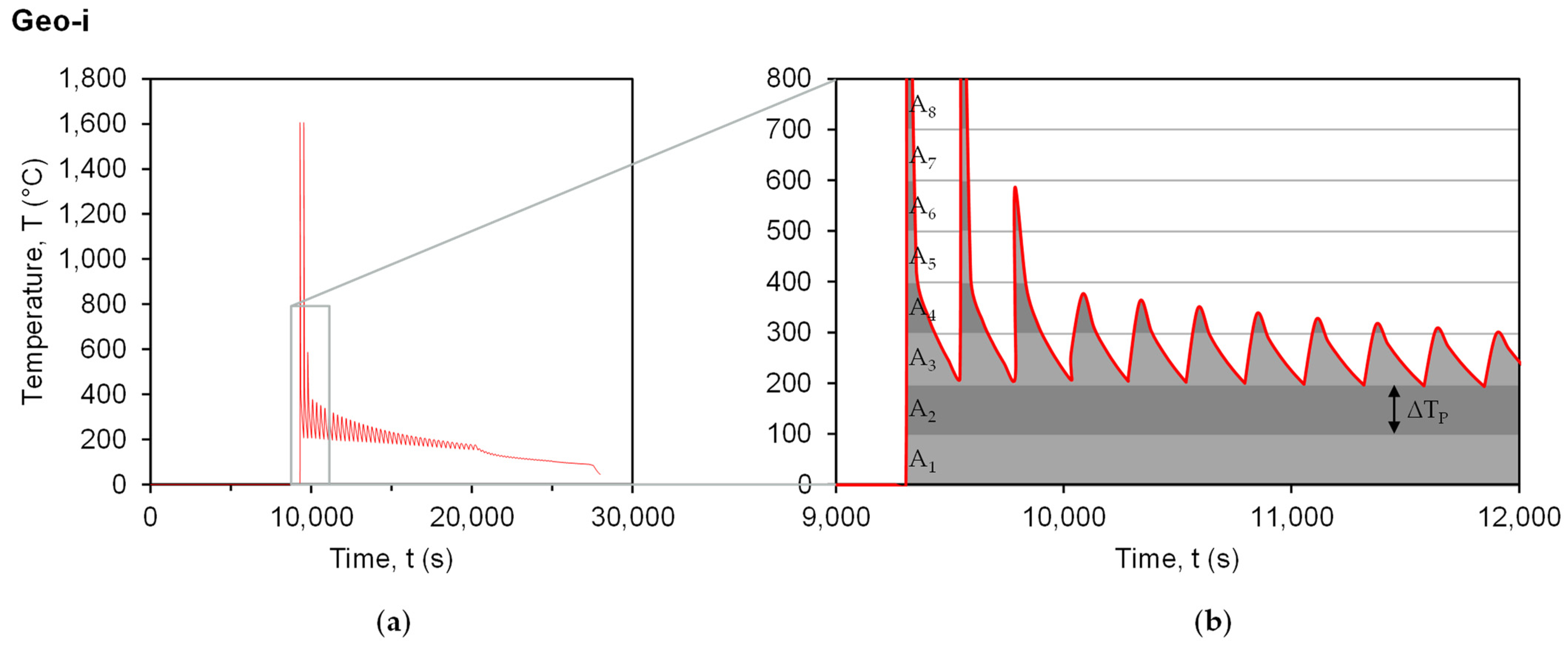

| Geometry variant, Geo- | a | b | c | d | e | f | g | h | i | j | k | l | m | n | o | p | q | r | s | t | u |
| Small diameter, d (mm) | 4 | 5 | 6 | 4 | 5 | 6 | 4 | 5 | 6 | ||||||||||||
| Large diameter, D (mm) | 17 | 20 | 23 | 17 | 20 | 23 | 17 | 20 | 23 | 17 | 20 | 23 | 17 | 20 | 23 | 17 | 20 | 23 | 17 | ||
| Overhang angle, δ (°) | 45 | 60 | - | ||||||||||||||||||
| Laser Power, PL (W) | Scanning Speed, vS (mm/s) | Hatch Distance, ∆yS (µm) | Layer Thickness, DS (µm) |
|---|---|---|---|
| 350 | 1100 | 120 | 60 |
| Partition | Temperature Range (°C) | Consideration in Model (x = Yes) | |||||||||
|---|---|---|---|---|---|---|---|---|---|---|---|
| 0–50 | x | - | - | - | - | - | - | - | - | - | |
| 50–100 | x | x | - | - | - | - | - | - | - | - | |
| 100–150 | x | x | x | - | - | - | - | - | - | - | |
| 150–200 | x | x | x | x | - | - | - | - | - | ||
| 200–250 | x | x | x | x | x | - | - | - | - | - | |
| 250–300 | x | x | x | x | x | x | - | - | - | - | |
| 300–350 | x | x | x | x | x | x | x | - | - | - | |
| 350–400 | x | x | x | x | x | x | x | x | - | - | |
| 400–450 | x | x | x | x | x | x | x | x | x | - | |
| 450–500 | x | x | x | x | x | x | x | x | x | x | |
| 500–550 | x | x | x | x | x | x | x | x | x | x | |
| 550–600 | x | x | x | x | x | x | x | x | x | x | |
| 600–650 | x | x | x | x | x | x | x | x | x | x | |
| 650–700 | x | x | x | x | x | x | x | x | x | x | |
| 14 | 13 | 12 | 11 | 10 | 9 | 8 | 7 | 6 | 5 | ||
| Coefficient of determination R2 (%) | 94.81 | 94.14 | 94.14 | 94.13 | 94.08 | 93.48 | 93.26 | 93.21 | 88.14 | 78.19 | |
| (%) | 82.69 | 83.27 | 85.34 | 86.94 | 88.16 | 88.15 | 88.77 | 89.55 | 83.06 | 70.92 | |
| (MPa) | 4.885 | 4.803 | 4.495 | 4.243 | 4.040 | 4.043 | 3.936 | 3.795 | 4.834 | 6.332 | |
Publisher’s Note: MDPI stays neutral with regard to jurisdictional claims in published maps and institutional affiliations. |
© 2022 by the authors. Licensee MDPI, Basel, Switzerland. This article is an open access article distributed under the terms and conditions of the Creative Commons Attribution (CC BY) license (https://creativecommons.org/licenses/by/4.0/).
Share and Cite
Munk, J.; Breitbarth, E.; Siemer, T.; Pirch, N.; Häfner, C. Geometry Effect on Microstructure and Mechanical Properties in Laser Powder Bed Fusion of Ti-6Al-4V. Metals 2022, 12, 482. https://doi.org/10.3390/met12030482
Munk J, Breitbarth E, Siemer T, Pirch N, Häfner C. Geometry Effect on Microstructure and Mechanical Properties in Laser Powder Bed Fusion of Ti-6Al-4V. Metals. 2022; 12(3):482. https://doi.org/10.3390/met12030482
Chicago/Turabian StyleMunk, Juri, Eric Breitbarth, Tobias Siemer, Norbert Pirch, and Constantin Häfner. 2022. "Geometry Effect on Microstructure and Mechanical Properties in Laser Powder Bed Fusion of Ti-6Al-4V" Metals 12, no. 3: 482. https://doi.org/10.3390/met12030482







